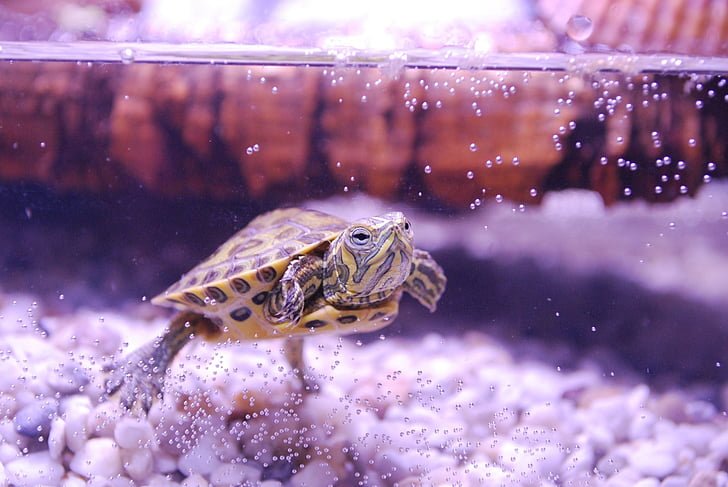Owning a pet turtle is an exciting experience. One of the most fascinating things about turtles is how long they can stay underwater. If you’ve ever watched your turtle swim, you might have wondered, how long can they stay underwater? The answer depends on factors like species, water temperature, and activity level. Some turtles need to come up for air every few minutes, while others can stay submerged for hours or even months during hibernation.
In this article, we’ll explore how pet turtles breathe, how long they can stay underwater, and what factors affect their breath-holding abilities. Let’s dive in!
How Pet Turtles Breathe
Turtles Need Air, Just Like Us
Even though turtles spend much of their time in water, they still need air to survive. Unlike fish, turtles don’t have gills. Instead, they use their lungs to breathe, which means they need to surface regularly. However, some turtles, like the painted turtle and the slider turtle, have developed special ways to stay underwater for longer periods.
One such adaptation is cloacal respiration, which allows turtles to absorb small amounts of oxygen from water through their cloaca (an opening for excretion). While this doesn’t fully replace normal breathing, it helps them stay submerged longer, especially when they’re resting or hibernating.
Water Temperature and Turtle Breathing
Warm vs. Cold Water
Turtles are cold-blooded, meaning their body temperature changes with the environment. In warm water, a turtle’s metabolism speeds up, so they use more oxygen and need to come up for air more often. In cold water, their metabolism slows down, allowing them to stay underwater longer because they need less oxygen.
For example, a turtle may need to come up for air every 30 to 45 minutes in warm water when it’s active. In colder water, however, they can stay underwater for hours, and during hibernation, some turtles can remain submerged for months.
As turtle expert Dr. James F. Spotila puts it,
“Turtles have remarkable physiological adaptations that allow them to survive in challenging environments, especially during prolonged periods underwater.”
Hibernation: How Turtles Stay Underwater for Months
What Happens During Hibernation?
During the winter months, some pet turtles, like painted turtles and slider turtles, go into hibernation (or brumation). When turtles hibernate, their body functions slow down drastically, and they need very little oxygen. This allows them to stay underwater for several months without coming up for air.
When in hibernation, turtles switch to anaerobic metabolism, which means they can produce energy without using much oxygen. They also use cloacal respiration to absorb small amounts of oxygen from the water, which helps them survive in freezing conditions.
Example:
- Painted turtles can hibernate underwater for up to 6 months, using very little oxygen while submerged in cold, icy ponds.
How Long Can Pet Turtles Stay Underwater When Active?
Active vs. Resting Turtles
When turtles are active, such as swimming or searching for food, they use more oxygen. On average, pet turtles stay underwater for about 30 to 45 minutes during active periods before needing to come up for air.
When turtles are resting or sleeping, their metabolism slows down, allowing them to stay submerged for much longer. It’s common for resting turtles to stay underwater for several hours without surfacing, especially at night when they’re less active.
Tip:
- Don’t worry if your turtle stays underwater for long periods when resting or sleeping. Their body uses less oxygen when they’re not active, allowing them to stay submerged longer.
| Turtle Species | Active Breath-Holding Time | Resting/Hibernation Time |
| Painted Turtle | 30 to 45 minutes | Up to 6 months during hibernation |
| Slider Turtle | 20 to 40 minutes | Several hours or weeks during hibernation |
| Mata Mata Turtle | 30 to 35 minutes | N/A |
| Snapping Turtle | 40 to 50 minutes | Several months during hibernation |
Factors That Affect How Long Pet Turtles Can Stay Underwater
Several factors influence how long a pet turtle can hold its breath underwater:
- Species
Some turtles, like painted turtles and sliders, can stay underwater much longer than others, especially during hibernation. - Water Temperature
In cold water, turtles use less oxygen and can stay submerged for longer. In warm water, they use more oxygen and need to surface more often. - Activity Level
Active turtles use more oxygen and need to come up for air frequently. Resting turtles can stay underwater for longer periods. - Water Quality
Clean, well-oxygenated water allows turtles to stay submerged for longer. Poor water quality may force them to surface more often to breathe.
Key Takeaways:
- Species, temperature, activity level, and water quality are important factors that determine how long a turtle can stay submerged.
Can Pet Turtles Drown?
Yes, turtles can drown if they can’t reach the surface to breathe. Although turtles are strong swimmers, pet turtles can drown if they get trapped underwater or if a pond freezes and they can’t come up for air.
Safety Tip:
- Ensure your turtle’s tank or pond has easy access to the surface, and check for any objects that could trap them underwater. If they live in a pond, make sure they can breathe even if the water freezes.
Tips for Pet Turtle Owners
To keep your pet turtle healthy and safe, follow these tips:
- Monitor Water Temperature: Ensure the water temperature stays consistent. Warm water causes turtles to surface more often, while colder water allows them to stay underwater longer.
- Provide Clean Water: Make sure your turtle’s tank or pond is clean and well-oxygenated. Regular water changes and a good filtration system are essential for maintaining a healthy environment.
- Understand Your Turtle’s Species: Some turtles hibernate, so it’s important to know if your turtle requires special care during the winter.
- Watch for Changes: If your turtle is surfacing more often than usual, it could be a sign of poor water quality or a health issue. Pay attention to their behavior and adjust their environment if needed.
Conclusion
Pet turtles are amazing creatures with the ability to stay underwater for different lengths of time depending on their species, water temperature, and activity level. While they typically stay submerged for 30 to 45 minutes when active, they can remain underwater for several hours or even months during hibernation.
By maintaining a clean and well-regulated environment and observing your turtle’s behavior, you can ensure your pet turtle stays healthy and happy in both water and on land.



